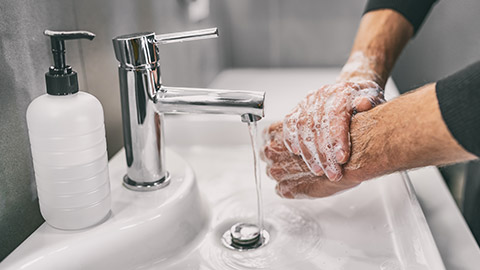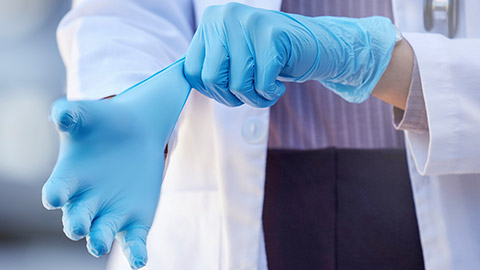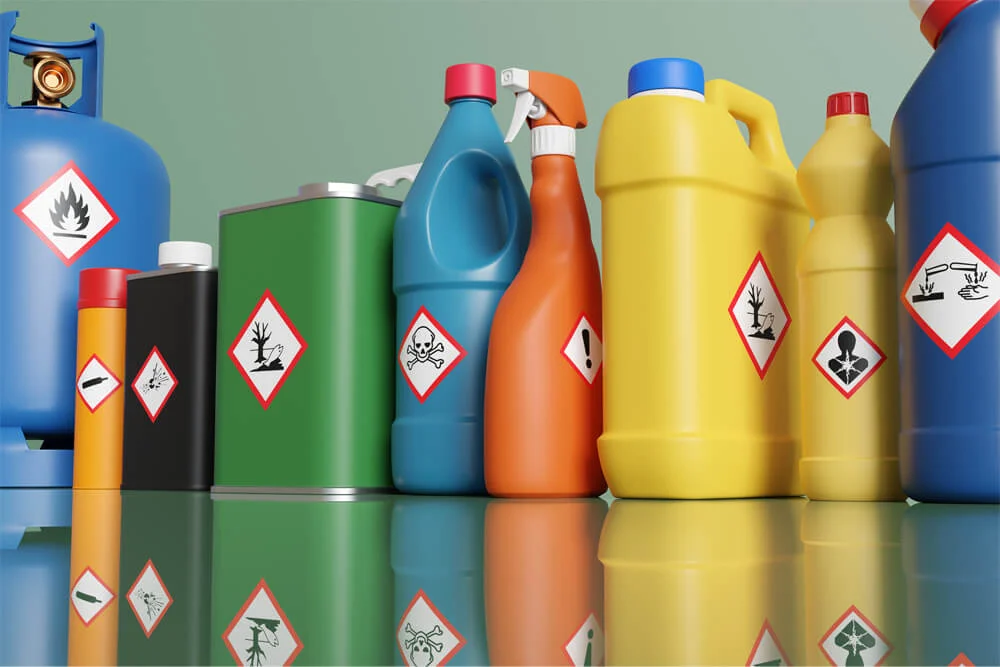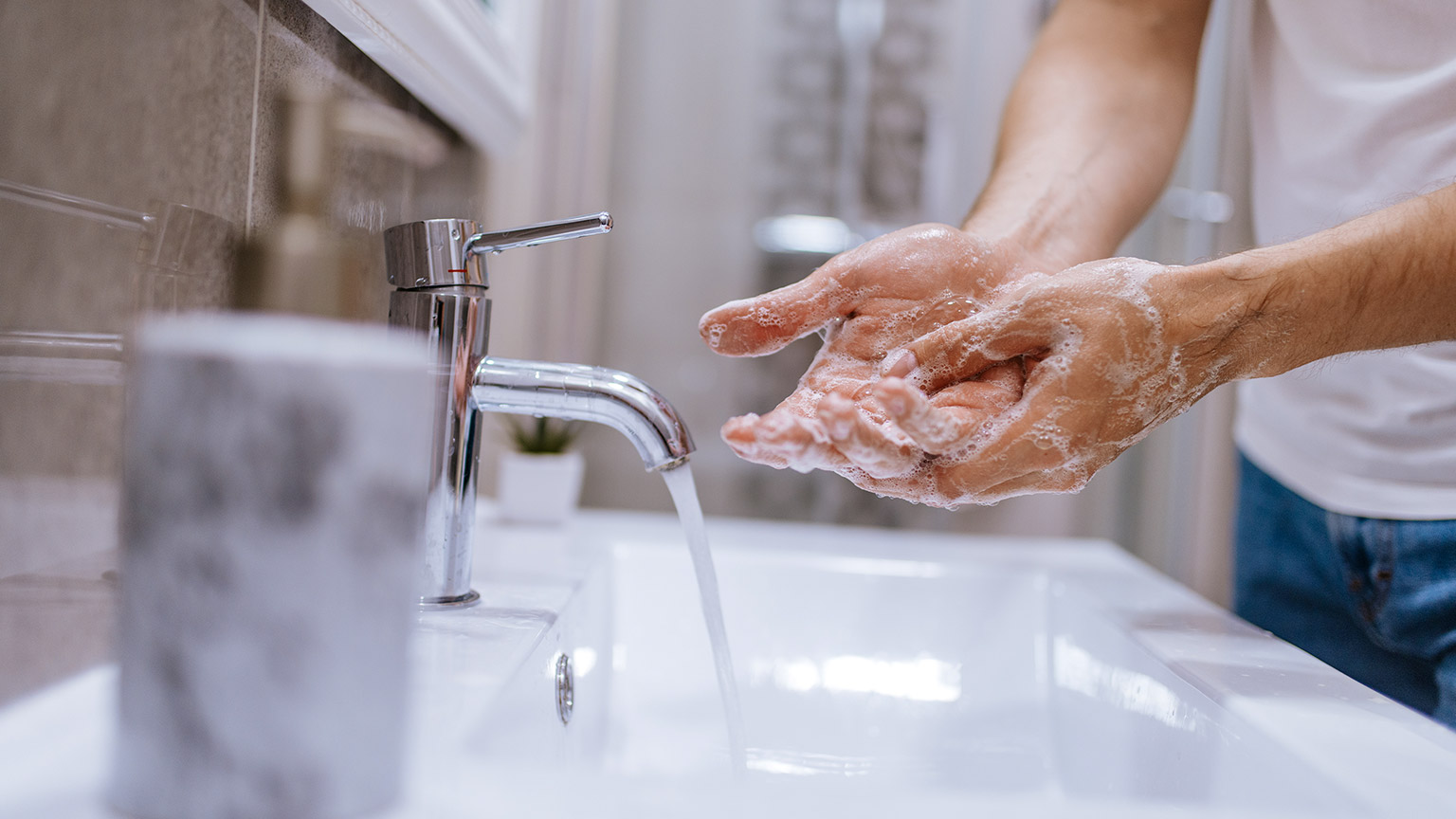Maintaining your hygiene and safety whilst working in an animal care environment is important for health and social reasons. Keeping your hands, head, and body clean and protected helps to stop the spread of germs and illnesses, protects you from injury, keeps your appearance professional and limits conditions such as body odour.
What Does Good Personal Hygiene Look Like?
The essentials of personal hygiene, especially when working in a professional environment alongside colleagues and customers, have been outlined in the following table:
| Hygiene practice | Reason for practice |
|---|---|
| Hand Washing | Helps to prevent the spread of germs and illnesses. |
| Dental Care | Wards off gum disease, bad breath, tooth decay |
| Bathing / Showering | Maintains clean hair and body and reduces body odour |
| Deodorising | Prevents body odour |
| Laundry | Ensures clean clothes by removing dirt, odours, and stains |
In addition to maintaining personal hygiene, you must also consider the importance of maintaining your personal safety.
What Does Maintain Personal Safety Involve?
When looking at personal safety, there are some specific measures you can take to ensure you are as safe as you possibly can be in your work environment. The following table outlines the safety measures to be taken and the reason for each measure.
| Protective measure | Reason for measure |
|---|---|
| Personal Protective Equipment (PPE) | Provides some protection against contaminants and impact/repetition injuries |
| Policies and Procedures | Provide guidance and step-by-step processes regarding the operation of equipment and the use of dangerous substances. |
| Signage | Informs you of a variety of potentially dangerous products, situations, or equipment. |
| Health and Wellbeing | Recognising signs of stress and fatigue before they impact you too much |

Handwashing is one area of hygiene that we are no strangers to, especially when working with animals. Handwashing is an integral practice that is not to be taken lightly or missed. Ineffective or infrequent hand washing and other personal hygiene practices are some of the most common causes of disease transmission. Hands should be washed under any of the following circumstances.
- When arriving at the clinic.
- Before and after handling animals (when conducting a medical examination, wash hands after each animal).
- Before and after surgery (this sort of handwashing also has its specific procedure).
- After conducting cleaning duties.
- After visiting the toilet.
- After handling money.
- Before preparing food items.
- Contact with any animal.
- Cleaning cages, equipment, or bedding.
- Undertaking venepuncture or giving an injection.
Required Equipment
There are specific types of equipment you will need access to when you are washing your hands. Many facilities and clinics have multiple examinations and consultation rooms where animals are taken to determine what help they need.
Every examination and consultation room should be equipped with
- a sink
- running water
- liquid soap dispenser
- paper towels.
There should also be Alcohol-based hand rubs provided for use in conjunction with hand washing techniques.
Cross-contamination when handwashing can occur if additional measures are not taken. It is also important to remember:
- bar soaps are not acceptable
- liquid or foam soap should be dispensed in a disposable pump or sensor-delivery dispenser
- soap containers should be refilled without being cleaned since there is a risk of contamination
- antibacterial soap should be used in critical care areas such as intensive care unit (ICU), in other areas where invasive procedures are performed
- dry hands with a disposable towel after washing.
The following table illustrates the various hand washing levels that will need to be carried out when working with animals. Ensure you have read through each level carefully and understood the process.
| Level | Washing technique | Duration | Drying | When needed |
|---|---|---|---|---|
| Routine handwash |
Do not touch taps with clean hands – if elbow or foot controls are not available, use a paper towel to turn taps off. |
At least 15 seconds | Pat dry using a paper towel, a clean cloth towel or a fresh portion of a roller towel. |
|
| Aseptic Procedure |
Do not touch taps with clean hands – if elbow or foot controls are not available, use a paper towel to turn taps off |
1 minute | Pat dry using a paper towel. | Before any procedures that require an aseptic technique (such as inserting intravenous catheters). |
| Surgical Wash |
No-touch techniques apply |
First, wash for the day 5 minutes; subsequent washes 3 minutes. | Dry with sterile towels. | Before any invasive surgical procedure. |
Aseptic Non-Touch Technique
The use of the Aseptic non-touch technique is designed to ensure that your hands, even if washed, do not contaminate sterile equipment or patients. Aseptic non-touch techniques can be achieved by using sterile gloves or forceps. The technique will help complement other procedures like the wearing of gowns and masks, and its use in any situation should be based on a risk assessment of that situation and the options available.
Animals of unknown history or health status should be handled with disposable gloves; however, wearing gloves does not remove the need to wash hands.
Watch
The following video demonstrates the recommended handwashing procedure that should be carried out each time you wash your hands.

As the name suggests, personal protective equipment or PPE provides you with protection when working in industries that present danger to a person.
We have reviewed PPE previously in the module relating more to the perspective of infection control and guidelines. Now we are revisiting it again from the perspective of hygiene and animal hygiene. There are some similarities in relation to the equipment used and the purpose, but the intention is slightly different.
Several industries require various types of PPE, including the animal care industry. It is important to remember that the use of PPE is an additional layer of protection; it does not eliminate a hazard or a risk. The following list outlines some of the benefits of wearing PPE in the animal care industry.
- Protection from pathological contamination of yourself or other animals from blood and other body fluids.
- Protection from injury.
- Protection from environmental conditions such as heat or the climate.
- It prevents damage and/or dirt/stains on your clothes.
Certain roles in the animal care industry will require higher levels of PPE than others; for example, animal technology workers in laboratories may interact with animals that have highly contagious diseases as part of scientific studies.
It is important to ensure your PPE is well maintained and that it fits you correctly.
Some examples of PPE that you may use in your workplace are:
Hair Net / Protective Hood
Helps to prevent loose hair from contaminating an open wound, incision, or food.
Goggles
Prevent contamination of the eyes from splashes, sprays and respiratory droplets. They must fit snuggly, particularly in the corners and across the brow.
Full-face shields can also be worn and have the added benefit of reducing transmission via the nose and mouth.
Masks

It helps prevent contamination of the mouth and nose from splashes, sprays, and respiratory droplets and reduces instances of hand-to-face contact that can occur subconsciously.
It can be a simple cloth or disposable paper mask or can be more industrial, such as the N95 mask, which has a built-in respirator that filters out airborne particles.
Other types of masks include full ventilation masks that are connected to an oxygen mix cylinder for use in Smokey or gaseous environments; however, these masks are less common in most workplaces as they are specific to certain industries or emergency personnel.
Gloves
Help to prevent hand contamination and the spread of infection between animals. Reusable (heavy-duty rubber) or single-use (latex, nitrile or vinyl) can be worn. There are also cut-resistant gloves.
Gloves must be changed regularly and should not be considered a replacement for hand washing. It is very important to wash your hands and wear gloves.
Protective Clothing
Prevents contamination of the skin and also protects personal clothing. Types include reusable cloth overalls (coveralls) and also disposable gowns.
Protective Footwear
Helps to prevent contamination in sterile areas and also damage to everyday footwear and can provide protection from crush injuries. Types include disposable shoe/boot covers, rubber boots, And steel-capped rubber boots.
Click each type of PPE on the following figure to reveal the description of each.
In addition to these types of PPE, other types of PPE need to be considered; if you are working outdoors, you should opt for:
- long-sleeved shirts
- sunscreen
- broad-brimmed hats
- sunglasses
Selecting the Right PPE
When it comes to PPE, the type of PPE you will use will depend on the risk level of the procedure you will be carrying out. The following table obtained from the Australasian Infectious Diseases Advisory Panel (AIDAP) provides you with some examples of risks to help determine the appropriate PPE to coordinate with the risk level.2
| Risk level | Description | Suggested PPE and Disinfection |
|---|---|---|
| Low risks are usually tasks that do not present a high level of danger. An example would include routine animal examinations. |
|
|
| Mild risks usually refer to tasks that have the potential to pose exposure to infectious materials such as Staphylococcus. |
|
|
| High risks refer to the possible exposure to highly contagious and dangerous zoonotic diseases such as Q-Fever. |
|
|
| Very high risks refer to the unusual and often exotic types of zoonotic diseases such as rabies. They are highly dangerous and transmissible. |
|
Watch
Check out this video on how to fit PPE.

When you decide to work in the animal care industry, you must keep in mind that in addition to being highly rewarding, it can also be quite stressful and confronting. In the animal care industry, you may encounter situations that cause psychological damage or stress. Some of these situations may include:
- overtime and working long hours
- shift work
- dealing with difficult and/or grieving clients
- animal suffering
- euthanasia of sick and sometimes healthy animals
- heavy workloads
- conflicts with colleagues
- workplace bullying/harassment
- compassion fatigue
Work-related stress is a significant health and safety issue and may have temporary or lasting effects on your mental health and physical well-being. It is important to be able to recognise the signs and symptoms of work-related stress and seek help from your supervisor/manager, a family member or close friend, a doctor, or a psychologist if you need help, just as you would take care of a wounded animal, you must also take care of yourself.
Some indications that you may be suffering from stress include:
- chest pain / pounding heart
- fatigue
- nausea, diarrhoea, or constipation
- low immune system - catching colds easily
- muscle tension and/or headaches
- fast, shallow breathing and/or excessive sweating
- changes to appetite
- sleep disturbances
- feeling overwhelmed or frustrated
- feeling guilty or unhappy
- crying regularly
- being irritable
- losing confidence and/or being indecisive
- negative thinking
- racing thoughts, especially at night that prevent you from sleeping
- memory problems
- excessive worrying.
As well you need to be aware of the risks you may encounter/ associated if you contract a Zoonotic Disease when working with animals.
It is important that people who handle animals, and people like vets who treat sick animals, are very aware of the risk of zoonotic diseases. There is always a risk that someone will acquire a zoonotic disease when working with animals. Several zoonotic diseases can be contracted. These diseases pose a threat to the health of other animals and staff. Depending on what disease is contracted, there are long and short-term effects on human health. Some examples include:
- Infant loss in pregnant women
- heart conditions
- vomiting
- diarrhea
- gastrointestinal worms
Watch
The next couple of videos discuss mental health and well-being in the animal care industry and mental health in general.
Trigger Warning
The next couple of videos do go into details of personal mental health experiences. Caution that discussions might be distressing.

In the animal care industry, ensuring a safe and hygienic environment for both animals and staff is paramount. Cleaning and disinfecting are crucial tasks, and understanding the numerical information found on cleaning product labels and instructions is essential for effective and safe use. Here’s a breakdown of key elements:
Quantity
Explanation: The amount of cleaning product used is critical to its effectiveness. Using too little may not adequately disinfect, and using too much can be wasteful and potentially harmful to animals and humans.
Example: A label may indicate that 50 ml of the product is required per 10 litres of water. Correctly interpreting this ensures the right concentration for effective cleaning.
Temperature
Explanation: Some cleaning products need to be used at specific temperatures to be effective. Using them at incorrect temperatures can reduce their efficacy or cause dangerous reactions.
Example: A product might specify that it should be used with water heated to 60°C. Understanding this ensures the disinfectant works as intended, providing the necessary level of sanitation.
Mixing Ratio
Explanation: The ratio of cleaning product to water (or another solvent) is crucial for ensuring the mixture is both effective and safe. Incorrect ratios can lead to ineffective cleaning or harmful residues.
Example: A common instruction might be to mix 1 part cleaning product with 4 parts water. Properly following this ratio ensures that the mixture is potent enough to clean without being overly concentrated and dangerous.
Application Rate
Explanation: This refers to how much of the mixed solution should be applied to a specific area or surface. Using the correct application rate ensures thorough cleaning and disinfection.
Example: An instruction might specify applying 100 ml of solution per square meter. Understanding and applying this rate ensures all surfaces receive adequate treatment.
Withholding Time
Explanation: Also known as contact time, this is the amount of time the cleaning product must remain on a surface to effectively disinfect it. Shortening this time can result in incomplete disinfection, while unnecessarily extending it can be inefficient.
Example: A product might require a contact time of 10 minutes to kill pathogens effectively. Adhering to this withholding time ensures the surface is properly disinfected.
Understanding and correctly interpreting these numerical instructions is crucial in the animal care industry for several reasons:
- Health and Safety: Proper use of cleaning products ensures the health and safety of animals by effectively removing harmful pathogens and reducing the risk of disease transmission.
- Regulatory Compliance: Adhering to prescribed quantities, temperatures, and contact times ensures compliance with health and safety regulations, which is critical for the operation of any animal care facility.
- Cost Efficiency: Correct usage prevents wastage of cleaning products, ensuring cost-effective operations without compromising hygiene standards.
- Environmental Impact: Proper dilution and application rates minimize the environmental impact by reducing the amount of chemicals released into the environment.

Measuring and Calculating Area
Explanation: Understanding and calculating the area of spaces such as kennels, enclosures, and play areas is crucial for several reasons:
- Animal Welfare: Ensuring animals have adequate space to move, play, and rest is vital for their physical and psychological well-being. Overcrowded conditions can lead to stress, aggression, and health issues.
- Hygiene and Maintenance: Knowing the area of an enclosure helps in planning and executing effective cleaning and disinfection routines. It ensures that sufficient cleaning products and resources are allocated for thorough sanitation.
- Facility Planning: Accurate area measurements are necessary for designing and arranging animal care facilities, ensuring optimal use of space and compliance with regulatory standards.
- Example: Calculating the area of a rectangular kennel (length x width) helps determine the amount of disinfectant needed for cleaning.
Measuring and Calculating Weight
Explanation: Accurate weight measurements are crucial for various aspects of animal care, including:
- Health Monitoring: Regular weighing of animals helps monitor their health, growth, and nutritional status. Significant weight changes can indicate health issues that require attention.
- Medication Dosage: Many medications and treatments are dosed based on the animal’s weight. Accurate weight measurements ensure proper dosing, which is essential for efficacy and safety.
- Diet and Nutrition: Determining the appropriate amount of food for each animal depends on their weight, ensuring they receive balanced nutrition without overfeeding or underfeeding.
- Example: Weighing a dog to calculate the correct dosage of medication based on a prescribed mg/kg dosage.
Measuring and Calculating Volumes
Explanation: Understanding and calculating volumes is important for:
- Feeding and Hydration: Ensuring animals receive the correct volume of food and water is essential for their health. Measuring volumes helps prepare and distribute the right amounts.
- Mixing Solutions: Accurate volume measurements are necessary when mixing cleaning solutions, medications, or nutritional supplements. Proper ratios ensure effectiveness and safety.
- Environmental Control: Calculating the volume of enclosures or rooms helps in managing ventilation, heating, and cooling systems to maintain a comfortable and healthy environment for the animals.
- Example: Measuring the volume of water for mixing a powdered supplement ensures the correct concentration for administration.
The ability to measure and calculate area, weight, and volume is vital in the animal care industry for several reasons:
- Animal Health and Safety: Accurate measurements ensure animals receive proper care, nutrition, and medical treatment, directly impacting their health and well-being.
- Resource Management: Efficient use of resources, such as food, cleaning products, and medications, relies on precise measurements, reducing waste and costs.
- Regulatory Compliance: Adhering to industry standards and regulations often requires specific measurements to ensure facilities and practices meet legal requirements.
- Operational Efficiency: Proper measurement and calculation streamline daily operations, from feeding schedules to cleaning routines, enhancing overall efficiency and effectiveness.
